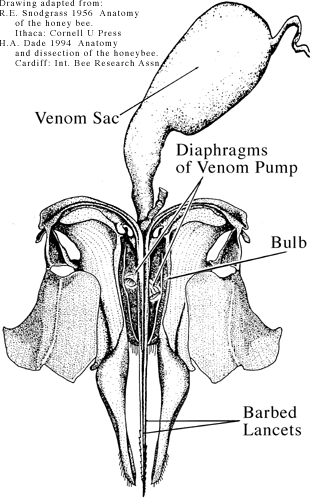
Defence Mechanisms
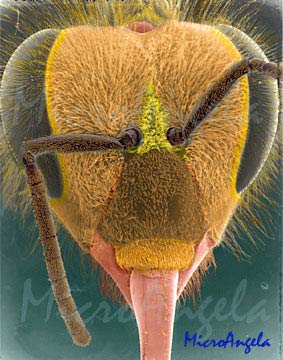
stinging
When a honeybee stings a creature, its barbed stinger becomes embedded in the flesh. When the bee attempts to withdraw, the stinger, along with the seventh abdominal segment, are detached and left in the victims flesh. The act of leaving behind the stinger serves a dual purpose. Firstly, the last nerve ganglion and the muscles which operate the poison sac are left in the flesh, so venom continues to be injected. Secondly, the stinger serves the purpose of marking the enemy, signalling other bees to join in the attack.

What exactly is it that signals the bees? When a stinging occurs, a highly volatile pheromone called isopentyl acetate,C7H14O2(seen below), is released. This substance is produced by the cells lining the sting pouch. This substance rapidly evaporates, attracting other bees to the source of the attack. This pheromone is produced by all four Apis species.
Apis mellifera produces another pheromone, 2-heptanone(below), which is involved in stinging action, serving to attract bees to the site of attack. However, this pheromone is comparatively weak, requiring concentrations of between 20 and 70 times that of isopentyl acetate in order to produce the same bee-attracting reaction.
isopentyl acetate
2-heptanone
pheromonal alarm system
Isopentyl acetate - the same pheromone involved in stinging - is also used for the purpose of a chemical alarm system. When a worker bee senses the presence of a possible enemy, it elevates its abdomen, opens its sting chamber and protrudes its sting, exposing the membrane in which the pheromone is kept. The bee proceeds to fan its wings in order to aid in the dispersal of the pheromone, which alerts and attracts the other bees in the nest, stimulating them to investigate and assess the situation. If necessary, an attack will be launched. Release of this pheromone at the nest entrance has the added benefit of reducing the number of bees which leave the colony, and thus increasing the strength of the defensive force.
intruder recognition
One of the most serious threats to the honeybee colony are bees from neighbouring colonies which attempt to raid others' honey stores in times of food shortage. In order to defend the colony, guard bees must be able to distinguish bees of their own colony from bees of other colonies. Bees are distinguished from one another based on their behaviour and odour. In a particular colony, all of the adult workers share the same odour, which is different from that of any other colony. Guards intercept both foreign bees as well as members from their own colony, at the nest entrance. The guard examines the entering bee's abdomen, and if necessary, uses its antennae to touch the bee, in order to identify it. The behaviour of the entering bee is crucial in determining its fate. Entering bees belong to one of four main categories: true colony member, dominant intruder, submissive intruder, or honey thief.
True colony member - this kind of bee will enter the nest, hesitate for only a second, before continuing. Since it has the same odour as the guard, it is accepted into the colony.
Submissive intruder - in a modern apiary, where there exists many rows of hives, it is common that a bee will accidentally stray into a foreign hive. Upon interception by guards, the bee will assume a submissive posture, tucking in the tip of its abdomen. The guards generally proceed to attack the intruder, pulling at its legs, wings and head, in attempt to remove it from the hive's entrance. Often the bee will preserve a submissive attitude during this attack, and will eventually be allowed to enter the hive. After a few hours, the bee will have acquired the odour of the colony (since bee odour is environmentally, as opposed to genetically inherited) and are no longer susceptible to examination. Only if the bee retaliates will it initiate a stinging response in the guards, as they attempt to kill the intruder.
Dominant intruder - Interestingly, if this straying bee has returned from a successful foraging expedition, it confidently enters the hive without hesitation. The guard bees will try to intercept it, or follow it, examining its abdomen, but not attempting to molest it. Since the entering bees' dominant behaviour matches the behaviour of foragers which are true colony members, it is accepted into the colony.
Honey thief - when a bee is attempting to raid a neighbouring nest, it engages in a very distinct jerky swaying flight, moving to and fro at the hive entrance. Since this type of behaviour is very recognizable to other bees, it is difficult to understand where the advantage lies. Likely, such behaviour facilitates escape if necessary, as well as functioning to alert other bees from its colony, in order to help with the raiding. If a guard seizes the robber, the two bees engage in battle until one is killed.
 Bee-home Again |
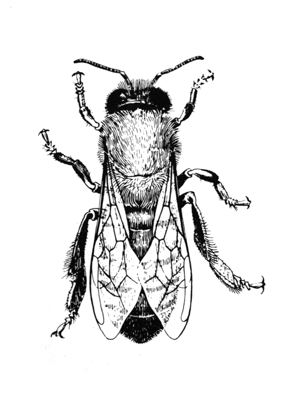 Colony: Division of Labour |
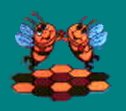 Dances with Bees |
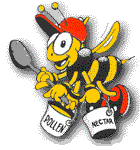 Foraging |
 Mating |